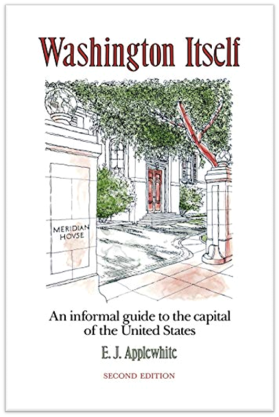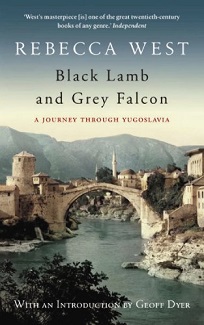E.J. Applewhite’s Washington Itself offers an unsurpassed introduction to DC.

In 1994, I arrived in Washington, DC, for the first time to start an internship in the House of Representatives. I was an ambitious, unqualified public-university student from California with an inferiority complex about the East Coast. The District deeply impressed and intimidated me: Institutions and organizations that I’d only seen on television or heard about on NPR were now very tangibly real.
My interest in architecture and design was vast, but my experience and understanding were not. California doesn’t have a lot of classical-revival architecture, and the brick and mortar common in the East triggered panic in me just months after Los Angeles’ Northridge earthquake. So, I had no aesthetic understanding or schooling to interpret what I was seeing.
That’s when I stumbled across E.J. Applewhite’s Washington Itself, which, after 30 years, I can confidently assert is the best all-around guide to the District of Columbia as a city and seat of government. It is among my favorite books, in part because it defies categorization. It’s not Lonely Planet. It’s not history. It’s not a civics textbook. It’s not architectural criticism or urban-design theory. And yet Washington Itself manages to be all these things and much more, with an engaging, curious tone, erudition without pedantry, and enduring insight and historical depth long postdating its 1981 publication.
Edgar Jarret Applewhite Jr. (the Washington Post’s obituary misnamed him Edmund) was a colorful and curious character. Born in Newport News, Virginia, he graduated from Yale and served on the USS Belleau Wood in the Pacific during World War II. He joined the CIA in 1947 so he could see the world. (He contributed to one high-profile covert project, a tunnel in Berlin to tap Soviet communications cables.)
He retired from the CIA in 1970, lived most of his life in Georgetown, and died in 2005 at age 85. His only other published works are homages to or collaborations with H. Buckminster Fuller, the architect and futurist credited with developing the geodesic dome, tensegrity, and “Spaceship Earth.” Applewhite wrote confidently as a “conscientious amateur” about the things that interested him.
“I have been beguiled by the rich range of the city’s monuments and memorials,” he writes in Washington Itself, “sometimes moving in their symbolism and associations, sometimes embarrassing in striving for effects beyond their means, but always abounding in enough paradoxes and ambiguities to sustain the most jaded of observers.” He doesn’t judge the institutions and people who run them, but aesthetically, he is unrestrained. So imagine when I read Applewhite’s (figurative) demolition of my new workplace:
“The worst thing to be said about the Rayburn [House Office] Building is that the congressmen whose home it is don’t seem sufficiently embarrassed by it.”
Indeed, I experienced Rayburn as an agoraphobic version of the unnavigable Lumon headquarters in the Apple TV+ series “Severance.” Congress is the sole authority over its own physical plant; there is no accounting for spending or for taste. So it should surprise no one, Applewhite suggests, that committee rooms and member offices take up only 15 percent of the building. Rayburn has as many floors for parking as it does for people.
I don’t remember when or where I first came across Washington Itself. On long walks, I perused the proliferation of bookstores, new and used, that were still common across Washington before Amazon and AbeBooks. I probably bought the second edition first, which was new in 1993. I don’t own that original anymore, but I’ve given away, gifted, and/or replaced my own copy of the book more times than I can remember. Happily, while it’s been out of print for 30 years, you can still find used copies online.
Aside from the spare but detailed line drawings by Fred H. Greenberg, a graphic designer and illustrator who worked for the American Institute of Architects, the book is wholly a product of Applewhite himself. Its added value is the author’s genuine interest in what goes on behind all those neoclassical, brutalist, international, beaux-arts, art-moderne, and art-deco façades. He describes the capital’s architecture as a kind of institutional aesthetic, an allegory about our political identity as Americans.
That’s not to say this is all instinctive patriotic deference to the imperial capital. Applewhite can be irreverent and very funny. He describes the absurd travels of Horatio Greenough’s sculpture of a swole George Washington, seated and stripped naked to the waist, from Florence to the Capitol, where “the door had to be partially cut away to bring it into the Rotunda. And when it was finally installed the floor began to sink” into the crypt below. Eventually, sheepishly, George was banished to the Smithsonian Castle on the Mall. Today, it is displayed in the National Museum of American History, Applewhite noting that the low space where it sits could not accommodate the father of our country if he ever stood up.
Applewhite also defends certain maligned DC buildings. One is the now rapidly deteriorating FBI Headquarters on Pennsylvania Ave., NW, for which he “confess[es] a certain fondness…it may be ugly, but it is unbanal” when compared to the “ice cubes” that fill out downtown. Likewise, he lauds the brutalist Health and Human Services building at Independence Ave. and 3rd St., NW, as “a gutsy structure conveying a sense of power and energy” — not a description normally associated with federal bureaucracy.
Applewhite reminds us that fashions fade but are occasionally redeemed, such as evidenced by the magnificent Library of Congress’ Jefferson Building, which survived demolition threats from a “fickle and unsympathetic” establishment in the last century. He similarly redeems the old State, War, and Navy Building on 16th St., NW, now the Eisenhower Executive Office Building, part of the White House. President Harry Truman once said about this AI hallucination of a French Second Empire prompt, “I don’t want it torn down. I think it’s the greatest monstrosity in America.” Applewhite, for his part, notes that it was open to the public when he first entered it in 1941 to interview with the State Department, and that anyone could walk “through its two miles of corridors, mostly paved in diamond dominoes of black and white marble.” (Bill Clinton famously bicycled down those same corridors to spoof his last year in office.)
The second edition of Washington Itself was published, Applewhite claimed, because by the early 1990s, Washington was “virtually completed” along the vision of Charles L’Enfant. This is of course not true. The District has been torn down, rebuilt, backfilled, reclaimed, and paved over. Urban planning and significant investment have transformed certain areas. Gallery Place, for one, has changed entirely since I moved here.
While I was overseas, the Capitol Riverfront Business Improvement District in Southeast, the NOMA Business Improvement District in Ward 6, the H St. Corridor, U St., NW, and the Cap Center were all overhauled. The old convention center on H St., NW, didn’t warrant a mention in Applewhite’s 1981 edition and was demolished and replaced with the new Walter E. Washington Convention center at Lew Place, NW, in the early aughts.
It would be interesting to know what Applewhite might’ve thought about today’s DC. I like to imagine his gimlet eye assessing the International Spy Museum or the Museum of the Bible. His deep historical reading would illuminate his appraisals of the National Museum of African American History and Culture and the National Museum of the American Indian (the latter opened a year before his death, but he appears not to have written anything publicly about it).
Perhaps he would expand into the greater metropolitan area to take in the Pentagon, the Army and Marine Corps museums, the Air Force Memorial, and the Udvar-Hazy Center at Dulles. His curiosity certainly beguiled me and — who knows? — could beguile some new young person just arrived in the nation’s capital and wanting to know more about it.
James Thomas Snyder is an author, critic, and translator living in Falls Church, Virginia.
